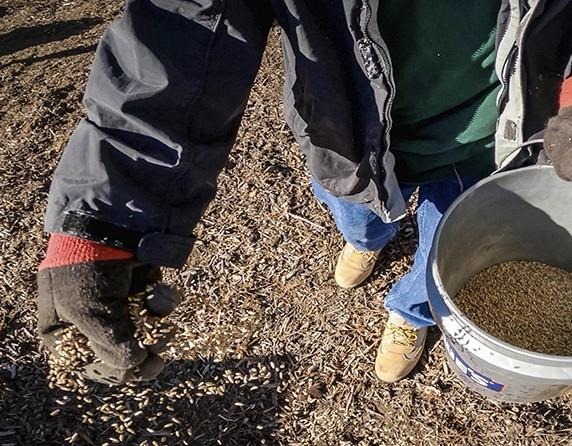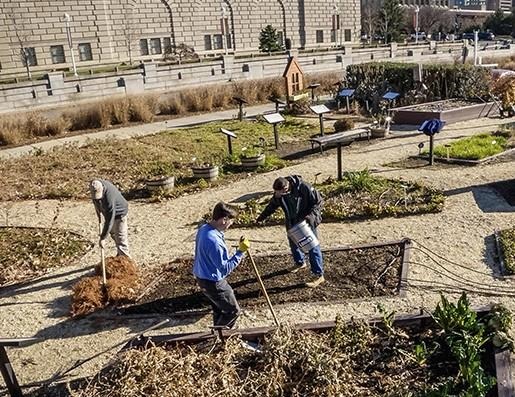David Kidwell-Slak, NRCS National Plant Materials Center Manager, and his team planted cereal rye, a cover crop that’s cold-weather hardy, that will help improve the soil and suppress winter weeds that may emerge.
 Dan Dusty, Farm Manager at the NRCS National Plant Materials Center, spreads cereal rye seeds in a planting bed in front of USDA’s Washington, D.C. Headquarters.
Dan Dusty, Farm Manager at the NRCS National Plant Materials Center, spreads cereal rye seeds in a planting bed in front of USDA’s Washington, D.C. Headquarters.
First, they start with one of the raised beds, temporarily removing the drip irrigation system – a “game-changer” for the home or urban gardener or farmer, says Kidwell-Slak, because it provides water to a bed whenever it’s needed, making crops more productive.
Then comes preparing the bed by raking, removing, and saving the now-brown, bald cypress tree leaves they’ve used to keep the soil covered through the summer and fall. They spread the cereal rye seeds over the soil by hand and lightly rake them in to make sure there is good seed-to-soil contact.
Next, comes lightly tamping down the soil with the side of the rake to make sure the soil stays put and adding back the dry bald cypress leaves to cover all the bare soil. Lastly, the drip irrigation system is returned.
Cover Crops Protect Against Climate Changes and Improve Water Quality
Besides the many other benefits, cover crops remove CO2 from the atmosphere and help make your soil more resilient to a changing climate. They lead to better water infiltration and water holding capacity in the soil and make the soil less susceptible to erosion from wind and water. In addition, cover crops trap excess nitrogen – keeping it from leaching into groundwater or running off into surface water – releasing it later to feed growing crops. This is a win-win, saving you money on inputs like water and fertilizer and making crops better able to survive in harsh conditions.
“So, if you do cover crops year-after-year, you see improvements in soil health, which ultimately lead to more resilient soils, better crop yields, and more conservation of resources,” said Kidwell-Slak.
 NRCS National Plant Materials Center (PMC) staff David Kidwell-Slak (PMC Manager), Shawn Belt (Horticulturist), and Dan Dusty (Farm Manager).
NRCS National Plant Materials Center (PMC) staff David Kidwell-Slak (PMC Manager), Shawn Belt (Horticulturist), and Dan Dusty (Farm Manager).
Wildlife Habitat and Livestock Forage
In addition to benefits for future crops, cover crops can provide winter food, cover, and nesting sites for birds and other wildlife, as well as forage opportunities for livestock producers. During the growing season, flowering cover crops can offer food and habitat for pollinators and other beneficial insects. This is particularly important in urban environments where wildlife habitat is scarce.
Come next May, Kidwell-Slak and his team will come back and cut down the rye and plant tomatoes, eggplant, or maybe sweet corn. Until then, he wants farmers and backyard gardeners alike to know that planting cover crops isn’t complicated.
 NRCS National Plant Materials Center Manager David Kidwell-Slak.
NRCS National Plant Materials Center Manager David Kidwell-Slak.
“It’s much easier than it maybe looks,” said Kidwell-Slak. “It seems really unlikely that you’re planting a seed in October that’s going to somehow magically do something good for you…and they provide a lot of benefits without much effort. It makes a pretty amazing addition to the garden.”
Source : farmers.gov